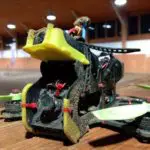Getting the right propellers for your FPV drone is crucial. Here are the things to consider when buying FPV props, and the best propellers that you can buy.

How Does A Propeller Work
When a propeller spins through the motors, it generates a massive wind downward. When the force generated exceeds the gravity, the drone is lifted up. By controlling the speed of the motors, the props generate more or less force, also known as thrust, which causes the drone to ascend, descend, accelerate and decelerate.
Specifications of Propellers
There are numerous types of props available in the markets. Each of them is characterized by different sizes, blade count, pitch, material, and design. All of those elements are essential in characterizing the speed, power and durability of the props, and whether they are suitable in different builds and purposes.
The size, blade count and pitch of props are often described in the below format:
L x P x B or LP x B or LP, where
L = length; P = pitch; B = blade count.
For instance, 5 x 4.3 x 3 Tri-Blade means 5” props, 4.3” pitch and 3 blades; iFlight Nazgul 5140 Tri-Blade has 5.1”, 3-bladed props at 4” pitch; and 51466 triblades is 5.1” in diameter and has 4.66” pitch.
Here’s a table that summarizes how the pitch, size and blade count of a propeller affect its performance.
| Specification | Small | Big |
|---|---|---|
| Size | Acceleration – fast Thrust – low Grip – low Power consumption – low | Acceleration – slower Thrust – high Grip – high Power consumption – high For – fast turning, sharp cornering |
| Blade count | Thrust – low Grip – low Acceleration – high Power consumption – low For – smaller drone Require – light frame | Thrust – high Grip – high Acceleration – low Power consumption – high For – fast turning, sharp cornering |
| Pitch | Top Speed – lower Thrust – lower Acceleration – fast For – small tracks requiring frequent turnings | Top Speed – higher Thrust – higher Acceleration – slow For – big field Require – more powerful motor |
Sizes
The size of the props that you would use depends on the body frame of the drone. Generally, you want to use the biggest props that your frame can support. That’s why you see 5.1″ props.
Obviously, bigger props generate more thrust when spinning due to bigger surface area. Because of the bigger surface area, it also “grips” better in the air, which makes it perform better in sharp corners. However, because the props are heavier, it requires more power to run.
In contrast, smaller props will generate less thrust when spinning. Similarly, due to the smaller surface area, it has less “grip” in the air. However, because the props are smaller and hence lighter in weight, it can accelerate and decelerate faster, giving you a feel that the drone is more “responsive” to your command.
Blade Count

Props may come with 2, 3, 4 or even more blades. The amount of blades affects how the drone flies, just like the size of the props.
Similar to a ceiling fan, the more blades your prop has, the more thrust (or “wind”) it generates. As the surface area increases due to the number of blades, it gives you better grip in the air, and hence it is more suitable for sharp cornering.
However, more blades means more energy consumption and lower acceleration due to extra weight from the blades. A prop with a lesser blade count behaves totally opposite to one with more blades.
2 blade props are usually used with a smaller drone or a lightweight frame which doesn’t require much thrust. In drone races, pilots usually settle with 3 blades for a balance between all the above elements.
Pitch
A pitch is the distance a prop would travel through a solid medium in a full rotation.
Imagine you are rowing. The angle of your paddle or oar when cutting the water determines how fast your canoe travels. The bigger the angle (from the horizon), the further it moves per row, which results in a higher pitch.
Using the rowing analogy, a higher pitch is associated with slower acceleration (it takes more effort to move your canoe from stationary), higher top speed (it moves faster than rowing at a lower angle), and the need for a more powerful motor (it is more tiring).
Conversely, props with smaller pitch can accelerate really fast and hence it is suitable for smaller tracks that require frequent turnings.
Material
Propellers are frequently manufactured in carbon fiber and polycarbonate or thermoplastics. Both have their own strengths and weaknesses as shown in the table below.
| Materials | Carbon Fiber | Polycarbonate |
|---|---|---|
| Price | More expensive | Cheaper |
| Strength | Stronger | Weaker |
| Stiffness | Stiffer | Less stiff |
| Weight | Lightweight | Heavier |
| Noise | Lower | Louder |
A carbon fiber prop is strong. It can withstand more crashes than plastic props. Being lightweight allows the props to respond faster when changing of speed is required due to lower rotational momentum compared with that of heavier props.
Due to its stiffness, it produces less vibration when spinning and hence, fewer noises and a more stable video feed. However, the stiffness is also an issue, where the blade easily chips or cracks as it crashes.
The other downside of carbon fiber props is the price, which is significantly higher than that of plastic props in the long run.
On the other hand, polycarbonate or thermoplastic props are cheaper. It is said to produce more thrust than a carbon fiber prop.
However, polycarbonate props are heavier, which causes them to respond much slower when a change of speed or direction is required during a race.
Because the polycarbonate props are not as stiff, it may bend instead of break in a crash. A bent prop needs to be replaced or fixed asap or it might affect the flight performance of your drone.
There are other materials used for props such as reinforced plastic and wood. However, those materials are not as popular as carbon fiber and polycarbonate due to their lower overall performance.
Design
Each prop has its own unique design. The manufacturers always try to make the design unique and eye-catchy to attract buyers.
Generally, the design doesn’t have any significant impact on the drone performance; they are mainly for aesthetic purposes. You can basically choose the one that looks the coolest for as long as the other criteria are fulfilled.
Weight
Usually, lightweight props are preferred over heavy props for 2 reasons.
Firstly, it reduces the all-up-weight of your drone. This is important if you want to keep your drone below 250 g. It also reduces the battery consumption since lesser energy is required to lift the drone (although it may not be significantly different).
Other than that, lightweight also means lower inertia, and hence, easier to change the rotation speed. It also means faster acceleration and deceleration.
As a result, your drone becomes more responsive in terms of movement.
Thrust and Efficiency
Ultimately, you need your props to produce thrust. Thrust is what moves your drone. The amount of thrust the props can produce is dependent on its design (and motor). You want your props to produce as much thrust as possible.
The specs of props can affect how much power is required to run it. For example, props with higher pitch require more power to run. This makes the motor less efficient – which means more power is consumed per thrust generated. Efficiency is the top priority for long range flight because you want to maximize the flight time.
If you are doing FPV racing, efficiency is not a big deal. What you need is thrust. Generally, the higher the thrust, the lower the efficiency.
Thrust and efficiency is the result of both props and motors combined. The easiest way to find out the best props in terms of thrust and efficiency for your motor is by checking miniquadtestbench. This website allows you to examine the thrust generated by different motor/props combinations so that you can choose the one that suits you the best.
Cost Factor
Props seem to be cheap, costing you ~30 cents to 2 dollars or more per piece, depending on the quality and size. However, do understand that props are essentially “consumables” especially in drone racing. You will need a lot of them. 2 bucks may seem cheap, but if you need to spend 2 bucks every flight, the amount can be substantial in the long run.
When to Change the Props?
Whenever you crash or hit something, the props may bend, break, or crack. Broken props need to be changed immediately, while bent props may still work. Simply bend the props back to its original position, and you can continue flying.
If you started feeling a weird flying pattern even after bending the props, you should change it.
Which Props Should Use?
It really depends. Obvious, the first thing to look at is the size of your drone. Can it fit 3″ props, or 5″? Then, you can look your purpose. Eg. do you need more thrust or efficiency?
In general, FPV race pilots use the biggest possible 3 blade props in races. The most commonly used props in a 5” drone race have pitch around 4-4.5”, and are made of polycarbonate or carbon fiber. Meanwhile, freestyle pilots use a variety of props based on their flight habits and preference.
Best FPV Propellers
Here is my list of best propellers for FPV drones.
Frame | GEMFAN Hurricane 51466 | HQProp DP | Nazgul F5 | Azure Power Johnny Freestyle | GEMFAN Hurricane 4023 | HQProp HeadsUp Tiny | EMAX AVAN Rush |
Buy from | |||||||
Size | 5.1" | 5.1" | 5.1" | 4.8" | 4" | 3" | 2.5" |
Pitch | 4.66 | 4.1 | 3.5 | 3.8 | 2.3 | 1.8 | 1.9 |
Weight | 4.13 g | 4.5 g | 3.9 g | 3.9 g | 1.98 g | 1.21 g | 1.4 g |
Blade count | 3 | 3 | 3 | 3 | 3 | 3 | 3 |
Material | Polycarbonate | Polycarbonate | Polycarbonate | Polycarbonate | Polycarbonate | Polycarbonate | Polycarbonate |
POPO support |
Final Thoughts
Props are probably the least complicated part to consider when building your drones. While you shouldn’t spend much time on the props, you shouldn’t neglect it either. I hope this guide helps you better in knowing what are the criteria to look for so that you can get the best prop that suits your needs the most.
Lastly, please make sure that you install your props correctly, at the correct direction.
Additional Information
What is POPO system?
POPO system is an innovation that allows pilots to put on and remove their props from the motors without using a wrench. While you need to use POPO compatible props on a motor with POPO to enjoy this feature, non-POPO components are compatible with each other.
The POPO system is going to become an industry standard, sooner or later.











